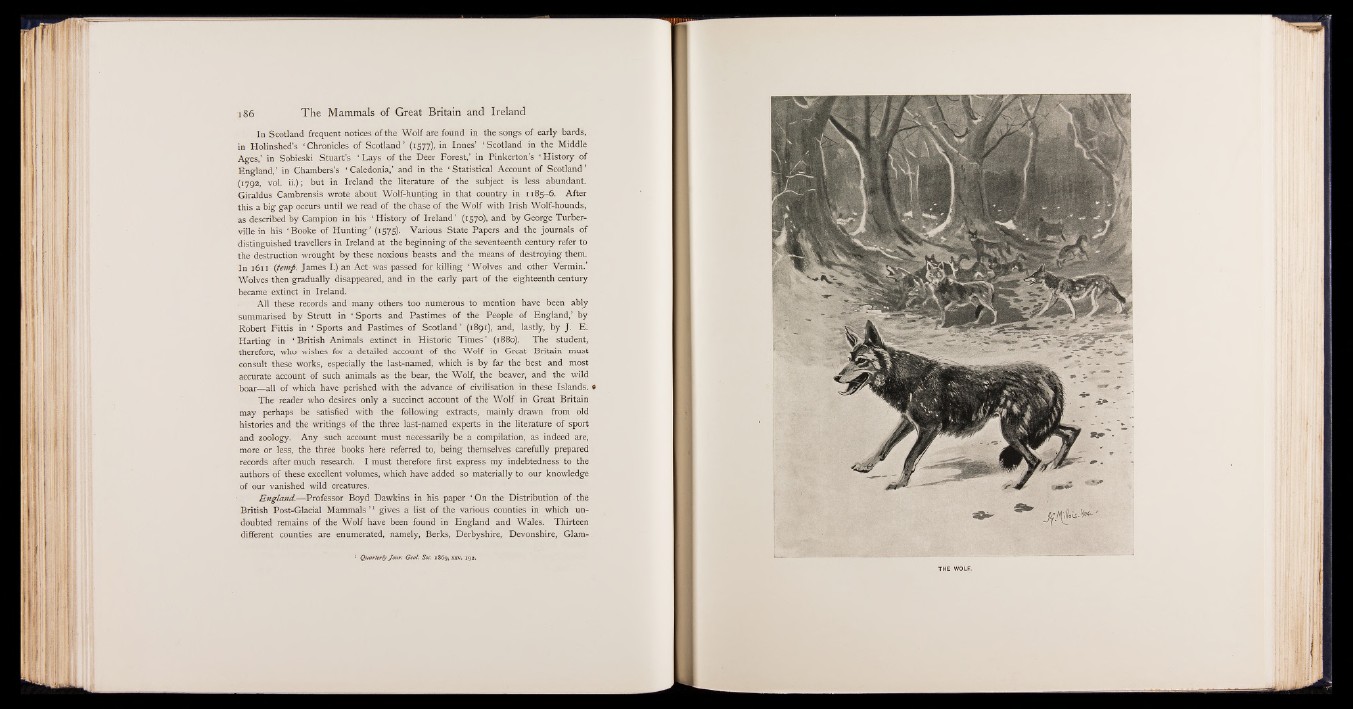
The 186 Mammals of Great Britain and Ireland
In Scotland frequent notices of the Wolf are found in the songs of early bards,
in Holinshed’s ‘ Chronicles of Scotland’ (1577), in Innes’ ‘ Scotland in the Middle
Ages,’ in Sobieski Stuart’s ‘ Lays of the Deer Forest,’ in Pinkerton’s ‘ History of
England,’ in Chambers’s ‘ Caledonia,’ and in the ‘ Statistical Account of Scotland ’
(1792, vol. ii.); but in Ireland the literature of the subject is less abundant.
Giraldus Cambrensis wrote about Wolf-hunting in that country in 1185-6. After
this a big gap occurs until we read of the chase of the Wolf with Irish Wolf-hounds,
as described by Campion in his ‘ History of Ireland’ (1570), and by George Turber-
ville in his ‘ Booke of Hunting’ (1575). Various State Papers and the journals of
distinguished travellers in Ireland at the beginning of the seventeenth century refer to
the destruction wrought by these noxious beasts and the means of destroying them.
In 1611 {temp. James I.) an Act was passed for killing ‘Wolves and other Vermin.’
Wolves then gradually disappeared, and in the early part of the eighteenth century
became extinct in Ireland.
All these records and many others too numerous to mention have been ably
summarised by Strutt in ‘ Sports and Pastimes of the People of England,’ by
Robert Fittis in 1 Sports and Pastimes of Scotland ’ (1891), and, lastly, by J. E.
Harting in ‘ British Animals extinct in Historic Times’ (1880). The student,
therefore, who wishes for a detailed account of the Wolf in Great Britain must
consult these works, especially the last-named, which is by far the best and most
accurate account of such animals as the bear, the Wolf, the beaver, and the wild
boar— all of which have perished with the advance of civilisation in these Islands. *
The reader who desires only a succinct account of the Wölf, in Great Britain
may perhaps be satisfied with the following extracts, mainly drawn from old
histories and the writings of the three last-named experts in the literature of sport
and zoology. Any such account must necessarily be a compilation, as indeed are,
more or less, the three books here referred to, being themselves carefully prepared
records after much research. I must therefore first express my indebtedness to the
authors of these excellent volumes, which have added so materially to our knowledge
of our vanished wild creatures.
England.— Professor Boyd Dawkins in his paper ‘ On the Distribution of the
British Post-Glacial Mammals ’ 1 gives a list of the various counties in which undoubted
remains of the Wolf have been found in England and Wales. Thirteen
different counties are enumerated, namely, Berks, Derbyshire, Devonshire, Glam-
1 Quarterly Jour. Geol. Soc. 1869, xxv. 192.